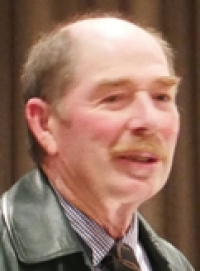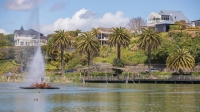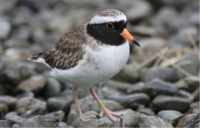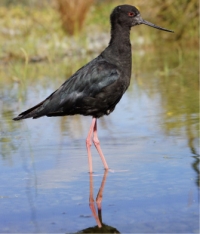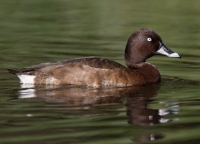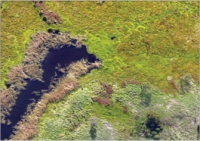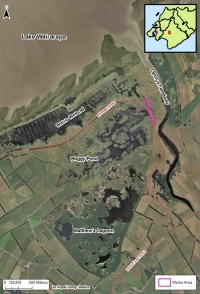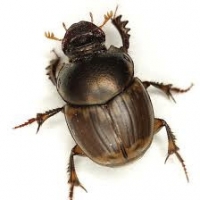Greetings everyone Hope Christmas and New Year treated you well; it has been an excellent year for waterfowl breeding, with most ponds holding water with lots of feed for young birds. The DU year has started with some small repair work being done to the wall at Wairio and the walkway from the road to Stage 1 being given a…
Published in
Issue 176
Tagged under
Ducks Unlimited NZ received an unexpected windfall in October – in the form of a $2000 bequest. Lifetime conservationist, author and former farm forester John Bracken Mortimer QSM, died at Waikato Hospital in May, aged 94. He was a former president of the New Zealand Farm Forestry Association. Many environmental groups and other organisations have benefited from Mr Mortimer and his wife Bunny’s generosity but their greatest legacy is Taitua…
Planning under way Planning for this year’s conference and AGM, which will be held in Wanganui/Whanganui from 2-4 August, is well under way. The conference venue and accommodation will be the Quality Inn Collegiate, a five-minute walk from the city centre. The programme will include a field trip to Bushy Park Homestead and Wildlife Sanctuary, with lunch at the category-1 heritage-listed Bushy Park…
Published in
Issue 176
Tagged under
DU director and bittern expert Emma Williams’ workload has become a whole lot busier after she was appointed science advisor (wetland birds) for the Department of Conservation in October. A fulltime job for four years, her main task is to deliver the national bittern research plan. The role also involves work with other wetland birds such as spotless crakes and marsh crakes with the…
Published in
Issue 176
Tagged under
Most improved river Ōtukaikino River in Canterbury took out the supreme award for most improved river at the New Zealand River Awards 2018 late last year. The river originates as a spring-fed stream on the Isaac Conservation and Wildlife Trust property, west of Christchurch. The stream supplies commercial salmon farming water races, flows through the Isaac Quarry and the trust’s captive bird breeding aviaries, and…
Published in
Issue 176
Four juvenile shore plovers (tuturuatu) were released on to Motutapu island in early February. The birds, which are critically endangered and number about 250 in the world, are endemic to New Zealand and among the world’s rarest shore birds. Pūkaha Mount Bruce National Wildlife Centre in the northern Wairarapa, which released the birds, hopes to release 21 more by the end of March. “This…
Published in
Issue 176
Tagged under
A record number of endangered black stilts (kakī) were released in the Mackenzie Basin in spring after the most productive captive breeding season on record. Overall 184 kakī were hatched and reared for release by the Department of Conservation, including 49 by the Isaac Conservation and Wildlife Trust (ICWT). In 1981, when the population plummeted to only 23 known birds in the wild, measures…
Published in
Issue 176
Tagged under
DU member Diana Chetwin was surprised to spot a rare visitor from the south and now her sighting has been officially confirmed. On December 2017 I was helping to launch a boat at Sandy Bay, Te Awaiti, South Wairarapa, when I heard the sound of pied stilts; looking down the beach, I saw two birds take flight. One appeared to be darker than the other.…
Published in
Issue 176
Tagged under
The white-eye, hardhead, brownhead, aythya australis australis, or karakahia is a pochard – a diving duck closely related to the scaup. Strangely, its Maori name is also used, as an alternative name for native grey duck or pārera. It is present in considerable numbers in eastern and south-western Australia. When it first appeared in New Zealand, is not known for certain, but…
Gordon Pilone tells the story of how Pohangina Wetlands, now protected by a QEII National Trust covenant, were created In 1995 Gordon and Anne Pilone bought a lifestyle block in Pohangina Valley, retiring there from Palmerston North where Gordon, originally from California, had lectured on and researched microbiology at Massey University and Taranaki-born Anne had established the best veggie and landscape gardens in town, which would…
Published in
Issue 176
Tagged under
Victoria University master’s student Patrick Hipgrave is using drones to map wetland vegetation for his project on geographic information systems (GIS). The project What changes in vegetation cover over time are evident at Wairio? To what extent is the accuracy of the image classification process improved with the addition of ancillary data? This project investigates the use of image classification techniques to…
Published in
Issue 176
A proposal to divert water from Matthews Lagoon through Wairio wetland has been given the green light. DU President Ross Cottle says he is delighted that the consent process has been finalised and work on “the final major part of the Wairio story to get a permanent water supply” is about to begin. The project, a collaboration with Ducks…
Published in
Issue 176
Tagged under
Ecologists from around New Zealand visited the Wairio wetlands on 29 November with DU President Ross Cottle and Stephen Hartley, of Victoria University, as their tour guides. The trip was part of the New Zealand Ecological Society’s annual conference in Wellington, and also included a visit to Pounui Lagoon and Onoke Spit, where Denise and Dougal Mackenzie were the guides. Student Patrick Hipgrave…
Dung beetles have joined the fight to clean up New Zealand’s waterways and Lake Wairarapa is a key target. In November the first region-wide release of non-native dung beetles in New Zealand began at an open day at Featherston’s Kaiwaiwai Dairies, in a paddock beside the farm’s wetland. The 0.75-hectare Kaiwaiwai wetland is part of the wider Wairarapa Moana wetland project, which includes…
Published in
Issue 176
Tagged under
New research highlights the importance of New Zealand’s wetlands for one of our most secretive native birds, the Australasian bittern or matuku, Conservation Minister Eugenie Sage said on World Wetlands Day, 2 February. GPS tracking of matuku/bittern has, for the first time, revealed that it flies more than 300km between wetlands in the eastern South Island as well as large distances between North Island…
Published in
Issue 176
Tagged under
Australian wildlife ecologist and bittern expert Matt Herring visited last year and took the time to catch up with his New Zealand counterparts. “The best thing we can do for nature is simply spend more time in it. From there, reverence grows and action flows.” M Herring, 2013 What a wonderful trip. It was as if we spent a week compiling precious…
Published in
Issue 176
Tagged under


